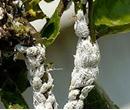






Mealy Bugs are one of the most annoying and destructive pests that attack houseplants. These tiny sucking insects look like small pieces of cotton. When young, mealy bugs have legs and can crawl. This is the best time to treat an infestation. A female mealy bug can lay over 500 eggs within a 1-2 week period. Mealy bugs suck the sap out of a plant, concentrating on the tender new growth; this causes spots on the leaves, yellow leaves, leaf drop, slow growth, and weak stems. While feeding on the plant, mealy bugs secrete a sticky substance called “honeydew” which acts as a breeding ground for “ sooty moldSooty Mold is a form of fungus that grows on the sugary honeydew secreted by aphids, scales, the whitefly, and other insects that suck the sap from plants. Sooty Mold is an unsightly black powder that can quickly coat the leaves of a plant in just a few weeks. The fungus itself doesn't really harm the plant; it just ruins the plant's appearance. Sooty Mold can be prevented by getting rid of the insects that secret the honeydew that attracts the Sooty Mold..” This mold covers leaves and stems ruining the plant’s appearance and interfering with photosynthesis. When mealy bugs are immature and crawling, use yellow sticky cardsThis small dark skinny pest flies and jumps around plants and people driving us all crazy. Fungus Gnats develop in moist potting soil, feeding on root hairs and emerging as adults every 30 days. The best way to get rid of Fungus Gnats is to allow the soil to thoroughly dry out. This eliminates the eggs and gnats in the pot. Use yellow sticky cards to trap the Fungus Gnats that are flying around. to trap them. Once they mature, Mealy Bugs should be sprayed with the green solutionIf you don't want to use a commercial chemical product to treat plant pest problems try the “Green Solution.” This is a mixture of water, alcohol, biodegradable liquid soap, and mineral oil. Always test any spray on one or two leaves to be sure it won’t damage the plant. Depending upon how severe the infestation is, you can use these ingredients in varying proportions. If there are only a few pests, dip a Q-tip in alcohol and gently swab them off. For a more widespread problem, start by using a spray of warm water mixed with a few tablespoons of biodegradable soap. If that doesn’t cure the problem, make a solution using 8oz. water & 8oz. alcohol, add two tablespoons of biodegradable soap and two tablespoons of mineral oil. Spray all areas of the plant. Use this solution on leathery leafed plants (except palms), never on fuzzy leafed plants like African Violets or Begonias. For palms, omit the alcohol from the Green Solution. Never spray a plant that’s sitting in the sun or one with very dry soil.. Be sure the plant is well-watered and not in the sun when you spray. Repeat this treatment every 10 days for a month to catch any further eggs that might hatch. On furry leafed plants dip a Qtip in the green solutionIf you don't want to use a commercial chemical product to treat plant pest problems try the “Green Solution.” This is a mixture of water, alcohol, biodegradable liquid soap, and mineral oil. Always test any spray on one or two leaves to be sure it won’t damage the plant. Depending upon how severe the infestation is, you can use these ingredients in varying proportions. If there are only a few pests, dip a Q-tip in alcohol and gently swab them off. For a more widespread problem, start by using a spray of warm water mixed with a few tablespoons of biodegradable soap. If that doesn’t cure the problem, make a solution using 8oz. water & 8oz. alcohol, add two tablespoons of biodegradable soap and two tablespoons of mineral oil. Spray all areas of the plant. Use this solution on leathery leafed plants (except palms), never on fuzzy leafed plants like African Violets or Begonias. For palms, omit the alcohol from the Green Solution. Never spray a plant that’s sitting in the sun or one with very dry soil. and wipe the mealy bugs off. Do not spray the entire leaf.
Copyright © www.100flowers.win Botanic Garden All Rights Reserved